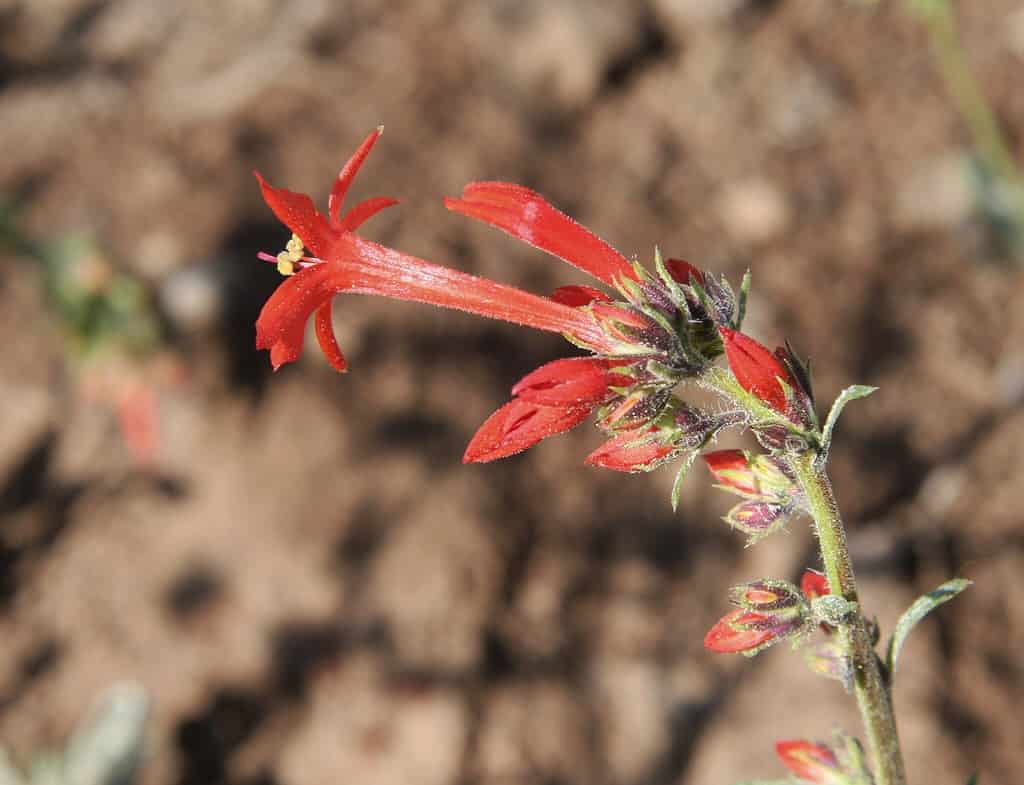While gardening is a wonderful hobby that provides an opportunity to customize and showcase our favorite blooms, there’s something magical about the beauty and chaos of wildflowers. These blooms are unplanned, untended to, and sometimes appear in the most unexpected places.
In this article, we’ll cover 23 beautiful types of red wildflowers to look for on your next outdoor adventure.
Let’s dig in!
1. American Trumpet Vine
Botanical name: Campsis radicans

The trumpet creeper grows in red, orange, and yellow.
©iStock.com/Michel VIARD
Also known as the trumpet creeper, this stunning red wildflower is named for its likeness to a trumpet. You may notice this creeping plant in shades of red, orange, or yellow contrasted by deep green leaves.
These beautiful blooms are lovely, with a sweet scent that attracts hummingbirds. However, they’re considered invasive in some areas. You’ll find it along the Eastern seaboard in the United States and throughout USDA zones 4-9, often growing along walls and gates. If left alone, the trumpet vine will choke out other plants and take over your yard.
2. Bee Balm
Botanical name: Monarda spp.
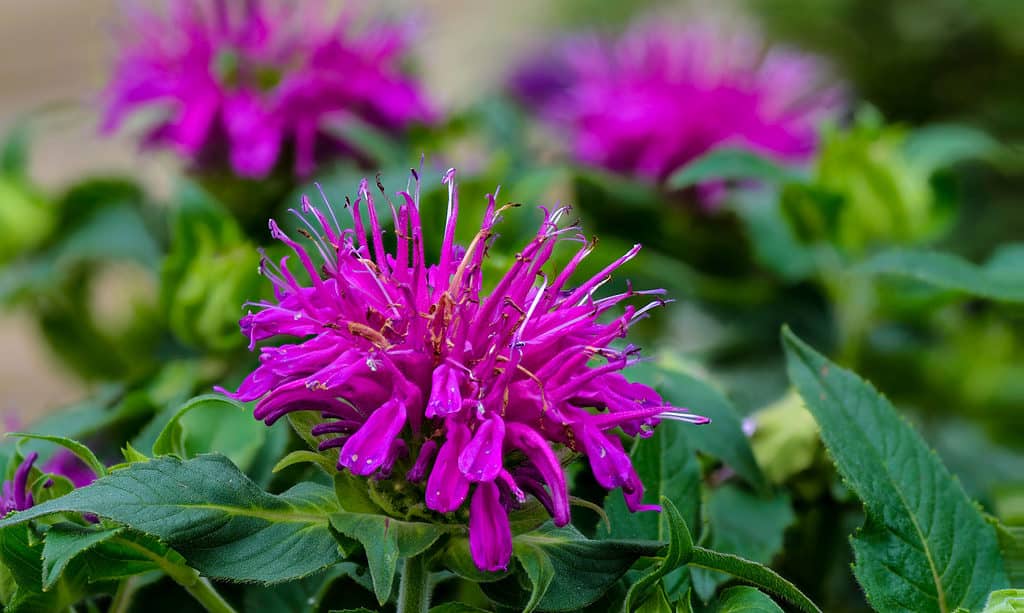
The wild bergamot plant is part of the
Lamiaceaefamily (known as the sage, mint, or deadnettle family).
©damann/Shutterstock.com
Also known as wild bergamot, this stunning red wildflower is another pollinator favorite — hence the name! You may also see this bloom growing in shades of fuchsia, white, and purple.
This lovely wildflower has unique, tubular petals that fan outward with the appearance of fireworks. Bee balm is taller than many other wildflowers, reaching up to 3-4 feet in height when left unchecked.
You can see these fragrant flowers in bloom in USDA zones 3-9 in June and July. They’re a hardy perennial that’s easy to grow and care for if you want to attract bees, butterflies, and hummingbirds to your garden.
3. Blanket Flower
Botanical name: Gaillardia spp.
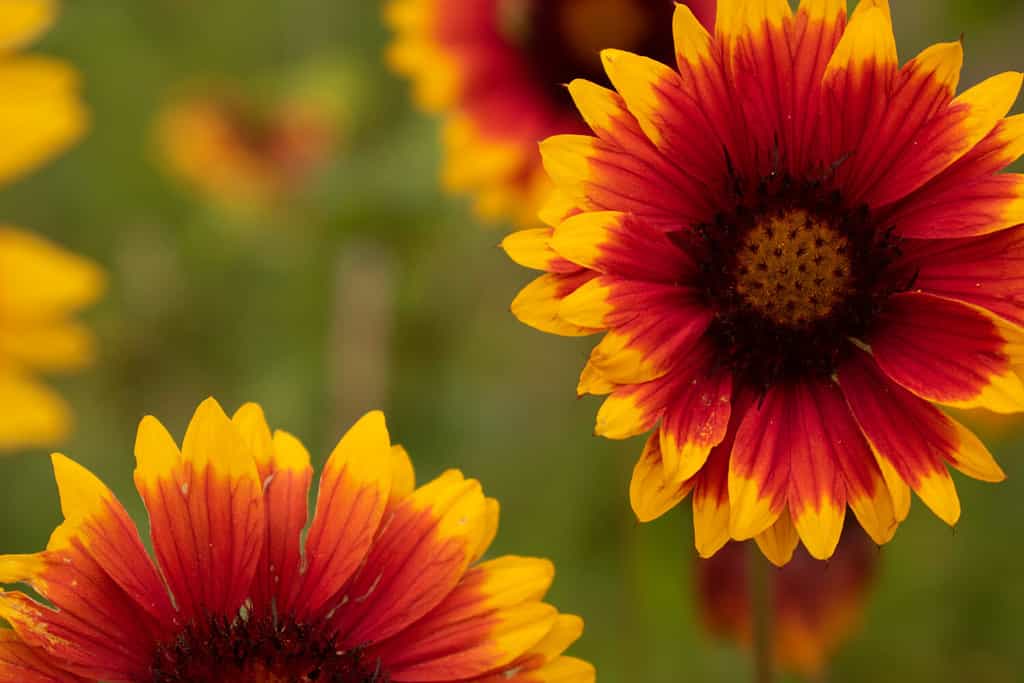
Blanket flowers are a popular type of red wildflowers.
©Venchelana/Shutterstock.com
Blanket flowers are one of the most commonly recognized blooms on this list. They’re named for their carpet-like growing habits and mosaic of red, yellow, and orange tones, reminiscent of woven tapestries and blankets at the time of their official discovery.
The blanket flower is similar to a daisy or sunflower, but many species boast unique petals with a delicate taper at the center and solid lines between different shades. Some species of Gaillardia have trumpet-shaped petals, almost like small, individual flowers growing within the parent plant.
You can find blanket flowers throughout the Northern United States and Canada in USDA zones 3-10.
4. Buckhorn Cholla
Botanical name: Cylindropuntia acanthocarpa
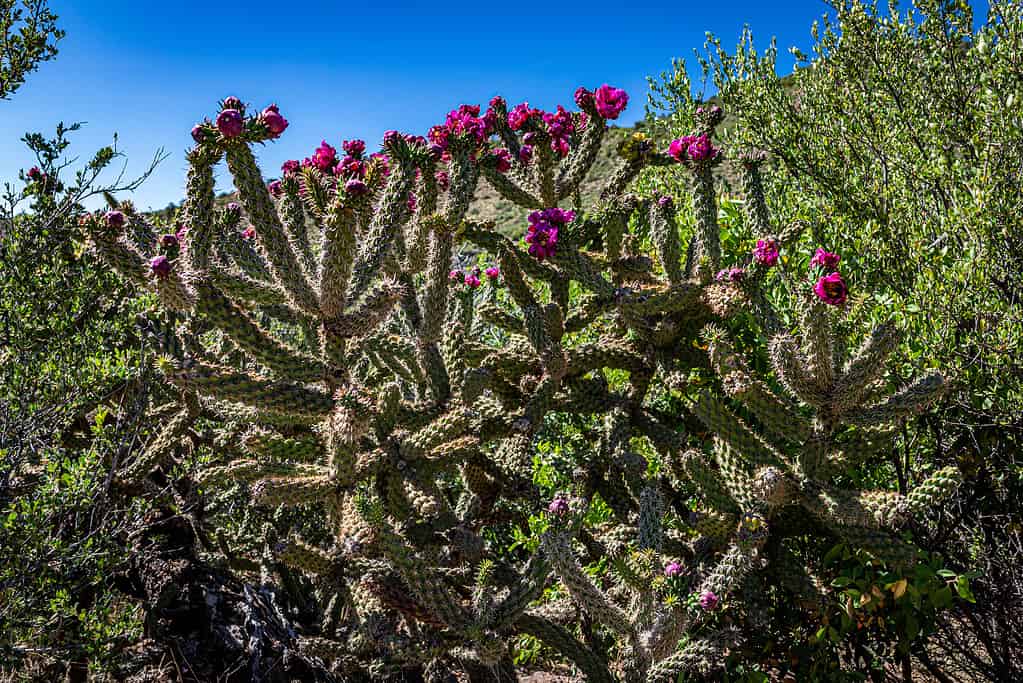
is a cholla native to the Mojave, Sonoran, and Colorado Deserts of North America.
©iStock.com/Different_Brian
The Buckhorn Cholla is a flowering cactus that’s considered a wildflower for its blooming habits and resilient nature. The stems of this cactus grow in spine-covered, tubular structures with clear segmentation — almost like a balloon animal.
When the Buckhorn Cholla blooms, the flowers are a deep scarlet with yellow centers. You may also see orange or yellow blooms.
This desert plant grows in arid climates in USDA zones 8-11. You can find it in parts of the Southern United States and throughout Mexico.
5. Cherokee Bean
Botanical name: Erythrina herbacea
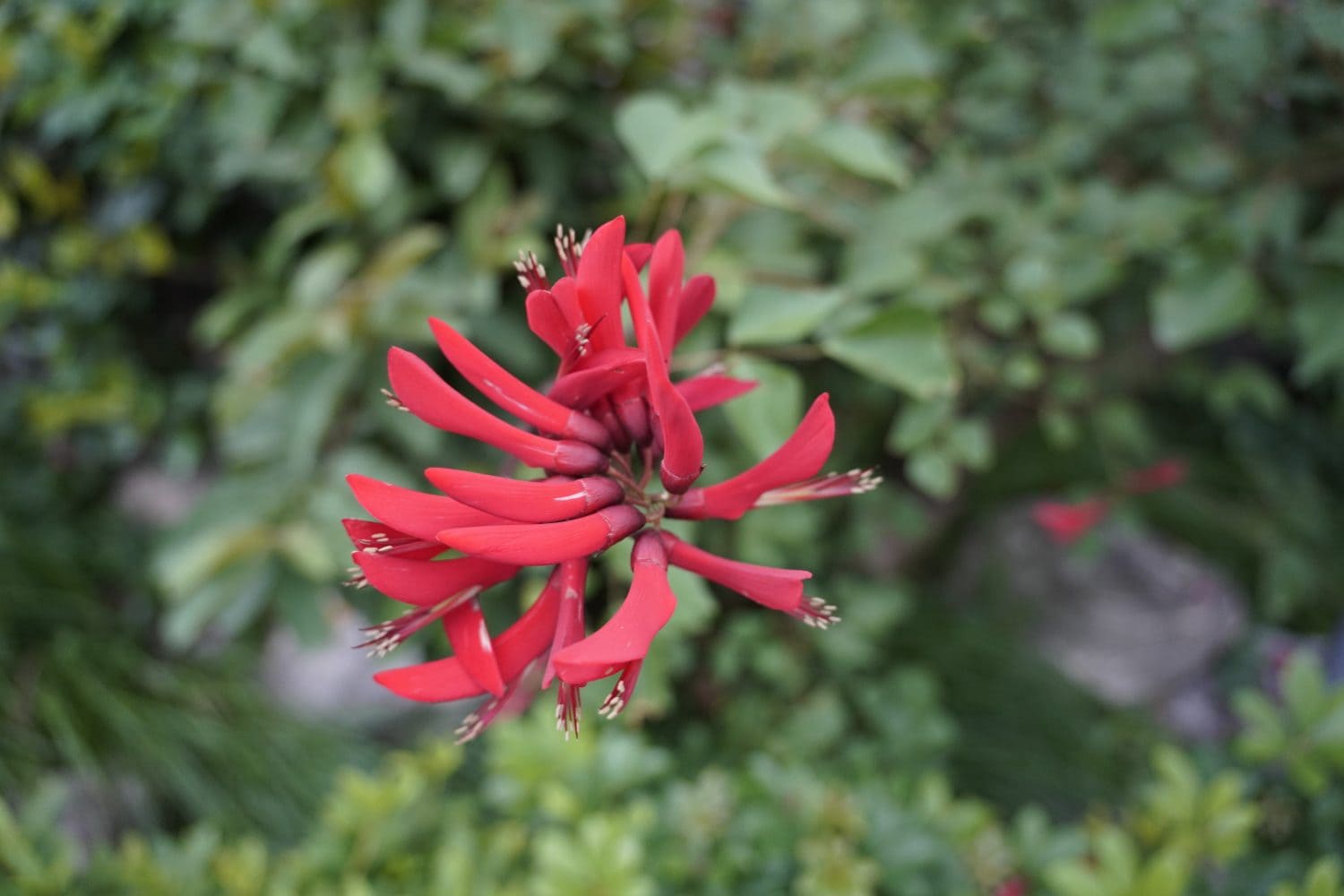
Also known as the Mamou plant, the Cherokee bean is a lovely red wildflower.
©Chang1979/Shutterstock.com
Don’t let the name fool you: the Cherokee bean is a stunning red wildflower. Also known as the Mamou plant or cardinal plant, this stunning flower is said to be endemic to the Southern United States, but there have been reports of cultivars in the Middle East, parts of Mexico, and Central America.
Erythrina herbacea has eye-catching, tubular scarlet petals that grow on woody stalks. The petals grow as individuals rather than in clusters, sprouting upward as they bloom and gently falling downward as they grow. The initial effect is similar to a lupine.
The Mamou plant will grow in USDA zones 8-11.
6. Common Poppy
Botanical name: Papaver rhoeas

Poppies are sometimes considered weeds in their native environment.
©Yuriy Kulik/Shutterstock.com
It may seem difficult to believe, but the poppy was once considered a weed by farmers. They’d remove this beautiful plant to protect their corn crops. Through these actions, the common poppy isn’t so common anymore.
The common poppy boasts the iconic poppy appearance, with delicate red petals surrounding a deep black center. It’s this flower that famously grew along the battlefields in World War II, leading to the famous poem In Flanders Fields.
You can still see this iconic wildflower growing along roadsides and fields in the U.K. Poppies will grow in USDA zones 3-10 with proper planning and care.
7. Eastern Red Columbine
Botanical name: Aquilegia canadensis
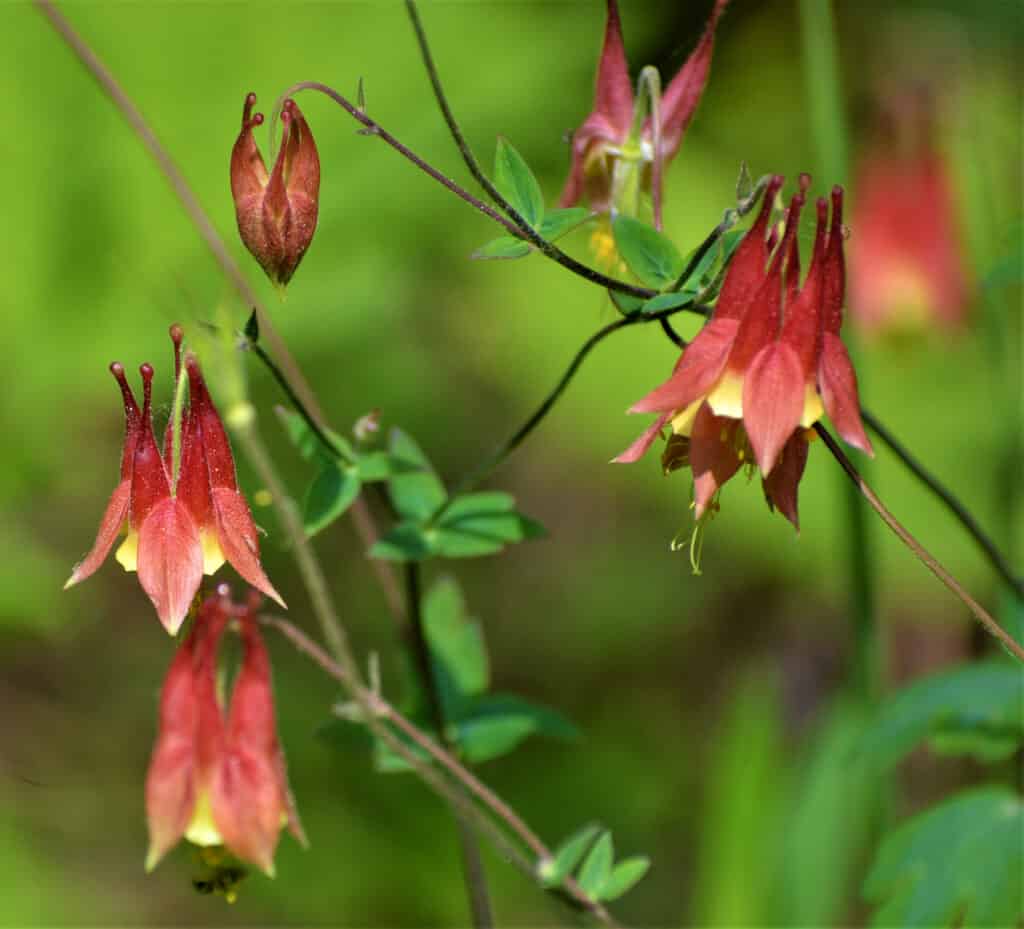
Red columbines are quite common.
©akslocum/Shutterstock.com
Columbines are another recognizable red wildflower. Gardeners and pollinators both love this bloom. It grows all across Canada and the Northern United States, punctuating green fields and forests with its bold red petals.
These stunning petals are bell-shaped with segmentation that sets them apart from the trumpet flower. You may also see these gardener favorites in shades of red or yellow. These flowers are hardy and self-seeding, but they’re not invasive.
Columbines grow in USDA zones 3-8. However, different species may be more suitable if you don’t live on the Eastern seaboard, like Aquilegia canadensis (the Western Columbine).
8. Indian Paintbrush
Botanical name: Castilleja spp.

A single stalk of bright red Indian Paintbrush.
©Nancy Strohm/iStock via Getty Images
The Indian paintbrush genus Castilleja consists of several species of these stunning red wildflowers. This hardy perennial is known to get brighter and bolder petals with each passing year of its return.
Red petals growing in a brush-like formation punctuate the tops of long, woody stems. A collection of these flowers waving in the breeze looks like an assortment of paintbrushes dipped in stunning shades of red.
This red wildflower is prevalent in the fields and prairies in Canada and throughout the United States. It will grow in USDA zones 4-8, with some reports of it growing as an annual in zones 9-11.
9. Indian Plume
Botanical name: Pedicularis densiflora
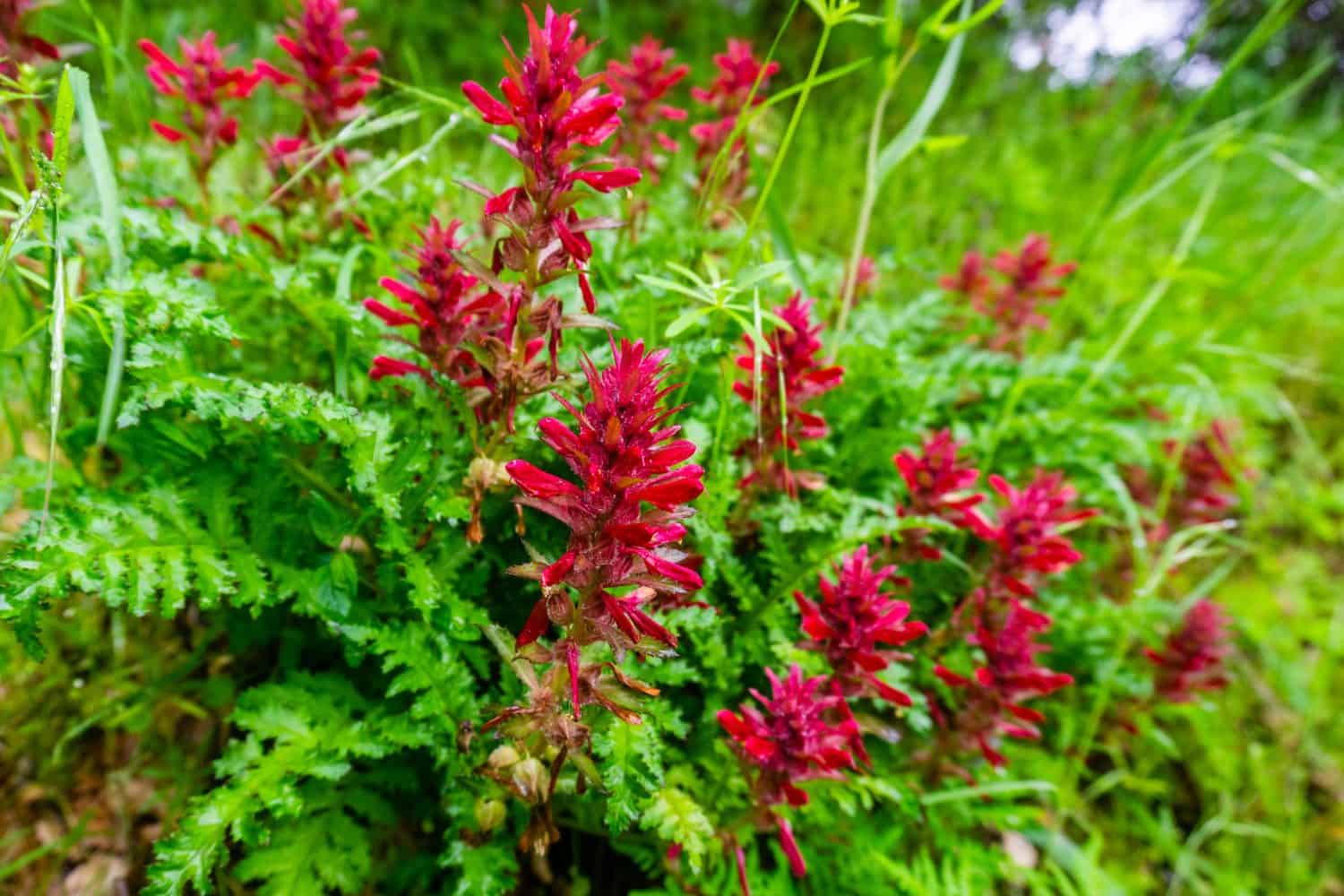
The Warrior Plume grows along the west coast.
©Sundry Photography/Shutterstock.com
Also known as the warrior flower or warrior’s plume, this spiky red wildflower grows along the West Coast, ranging from California up to Oregon and British Columbia.
Indian plume grows in vertical stalks, with tubular petals and bracts in deep shades of crimson contrasting vibrant green foliage. Despite its beauty, you don’t want to plant this parasitic plant near your garden. Pedicularis densiflora invades the root systems of nearby healthy plants and takes their nutrients.
10. Red Bush Monkeyflower
Botanical name: Mimulus puniceus syn. Diplacus puniceus
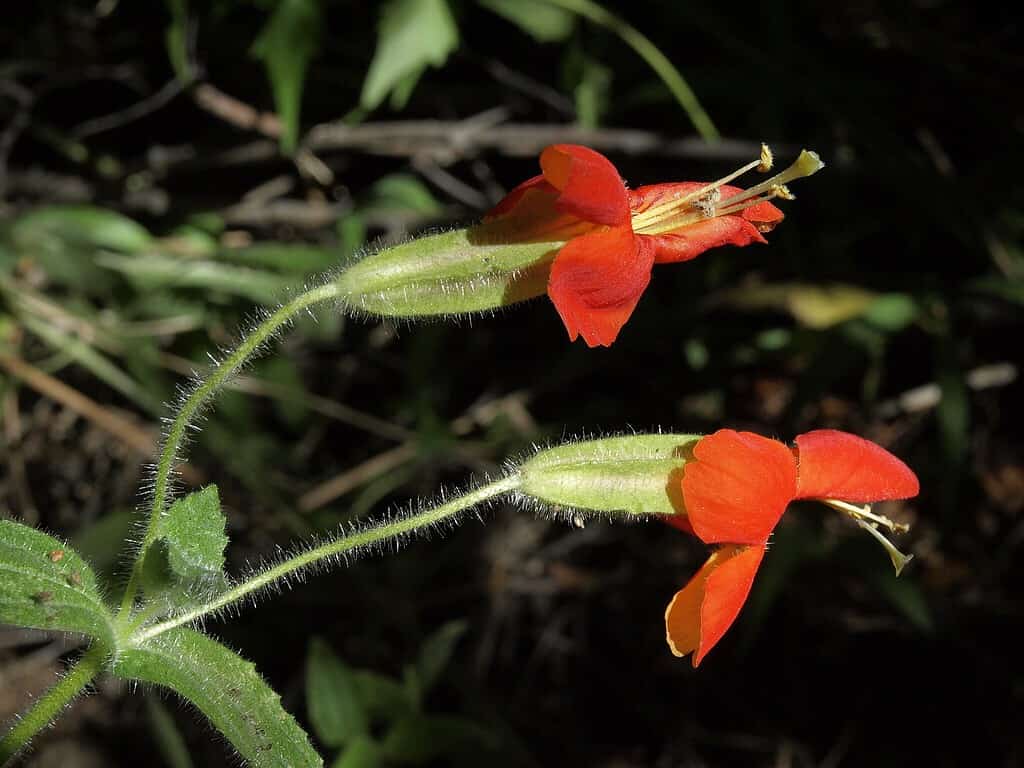
Monkeyflowers are said to look like monkeys with their tongues out.
©Jim Morefield from Nevada, USA, CC BY-SA 2.0 , via Wikimedia Commons – Original / License
These stunning red wildflowers grow throughout Southern California. This coastal bloom has five vibrant red petals with a contrasting center that’s said (by some) to look like a monkey’s face.
This perennial shrub has dark green leaves and can grow 5-6 feet tall. This summer bloomer attracts hummingbirds and other pollinators, adding to the beauty of its coastal origins. With proper care, these flowers will grow in USDA zones 3-9.
11. Prairie Smoke
Botanical name: Geum triflorum
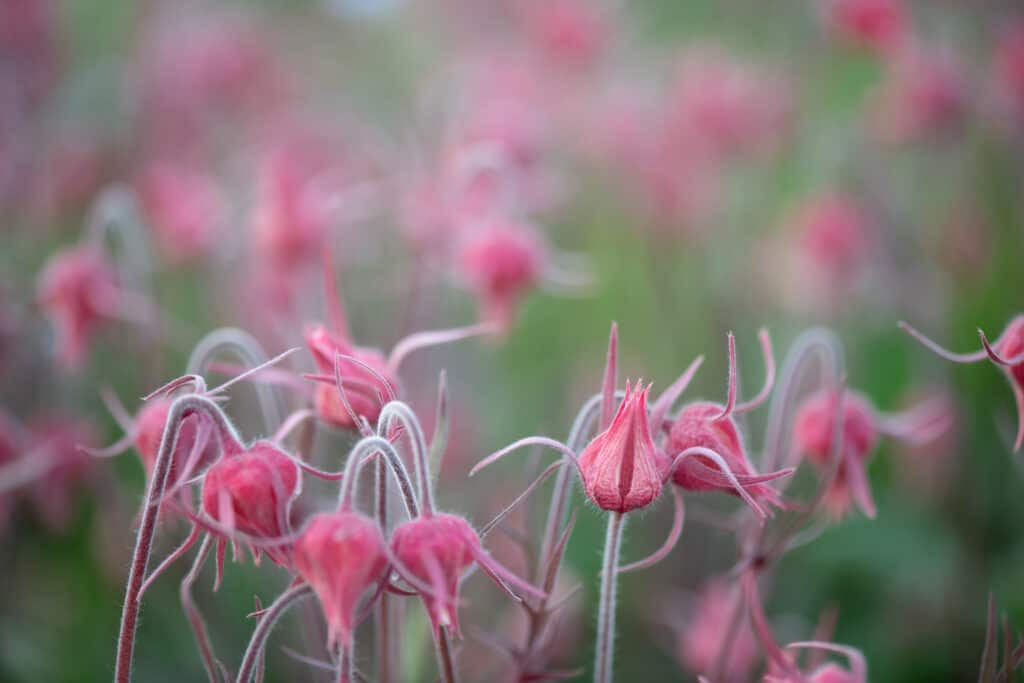
Prairie smoke is a beautiful perennial wildflower that is found in North American prairies.
©iStock.com/Page Light Studios
Prairie smoke is one of the most unique wildflowers of any color. Native to the North American prairies, this otherworldy bloom has thin, whispy petals that appear more like a puff of smoke than a flower. The delicate strands are a deep red that provides a pinkish glow in the sunset.
These unique red wildflowers are low-maintenance, thriving in USDA zones 3-7 with minimal care. While these strange-looking flowers may not seem like they’d attract pollinators, they play an important role as an early form of nutrients in their native environment.
12. Red Hibiscus
Botanical name: Hibiscus spp.

Hibiscus is a wildflower in some parts of the world!
©Nikolay Kurzenko/Shutterstock.com
There are several species of red hibiscus that grow in the wild, including Hibiscus moscheutos and Hibiscus coccineus. This tropical plant grows naturally in Asia, Mexico, and parts of Africa.
Red hibiscus plants share a few common features. They have five broad petals with a contrasting yellow center and vibrant green foliage. They thrive in USDA zones 4-9 (though some species do better in 8-9) in warm, humid climates.
13. Red Salvia
Botanical name: Salvia coccinea
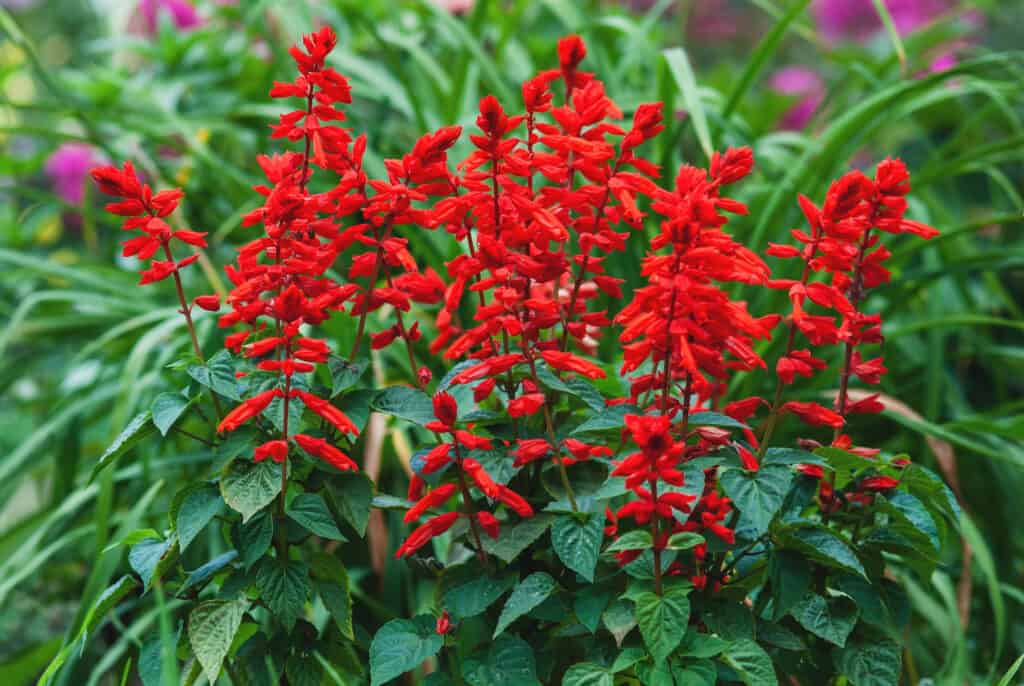
Scarlet sage salvia produces vibrant red flowers that hummingbirds and butterflies enjoy.
©iStock.com/Nadya So
There are several species of salvia, the most popular of which is a stunning purple shade. However, Salvia coccinea, also known as blood sage, is an incredible shade of red.
This species is native to South America and is quite prevalent in Brazil. Salvia grows in stalks with small cup-shaped blooms growing along the sides. These red tones contrast against the deep green foliage for a lovely, eye-catching display.
As a tropical species, red salvia only grows well in USDA zones 10-11. However, you can likely grow this wildflower as a summer annual in cooler regions.
14. Red Yarrow
Botanical name: Achillea millefolium ‘Red Velvet’
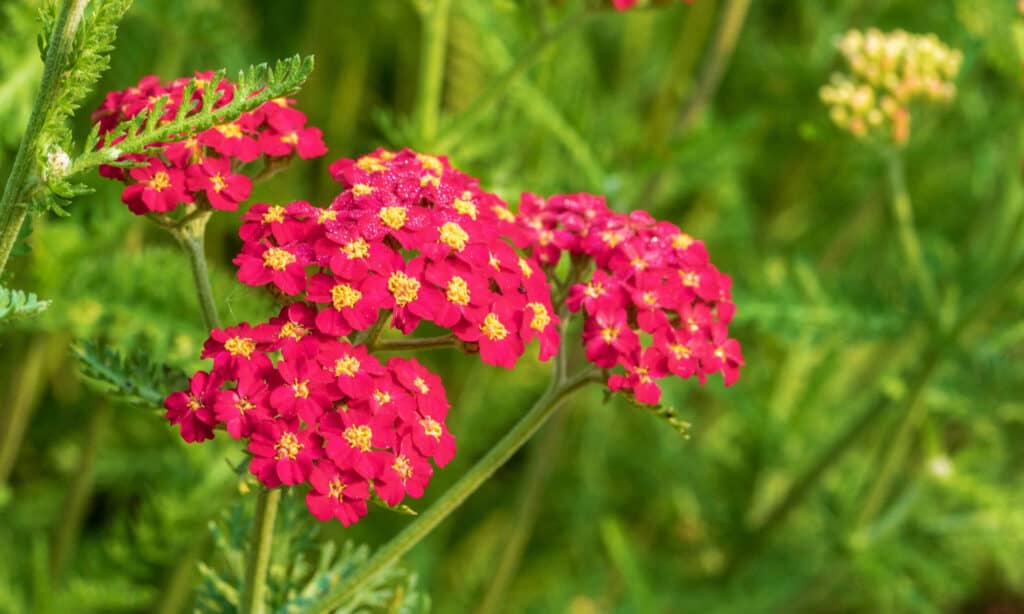
Red yarrow grows in clusters.
©Jennifer Yakey-Ault/Shutterstock.com
Yarrow is another well-known wildflower found throughout North America but is believed to be native to Canada. This lovely flower attracts pollinators and was used in traditional medicine to aid digestion and relieve stomach troubles.
Red yarrow has tiny crimson blooms with yellow centers. The flowers grow in large clusters with a fragrant aroma that attracts butterflies and bees while keeping deer and rabbits at bay.
This hardy Northern plant will grow in USDA hardiness zones 3-9 as long as it has full sun exposure.
15. Scarlet Catchfly
Botanical name: Silene virginica
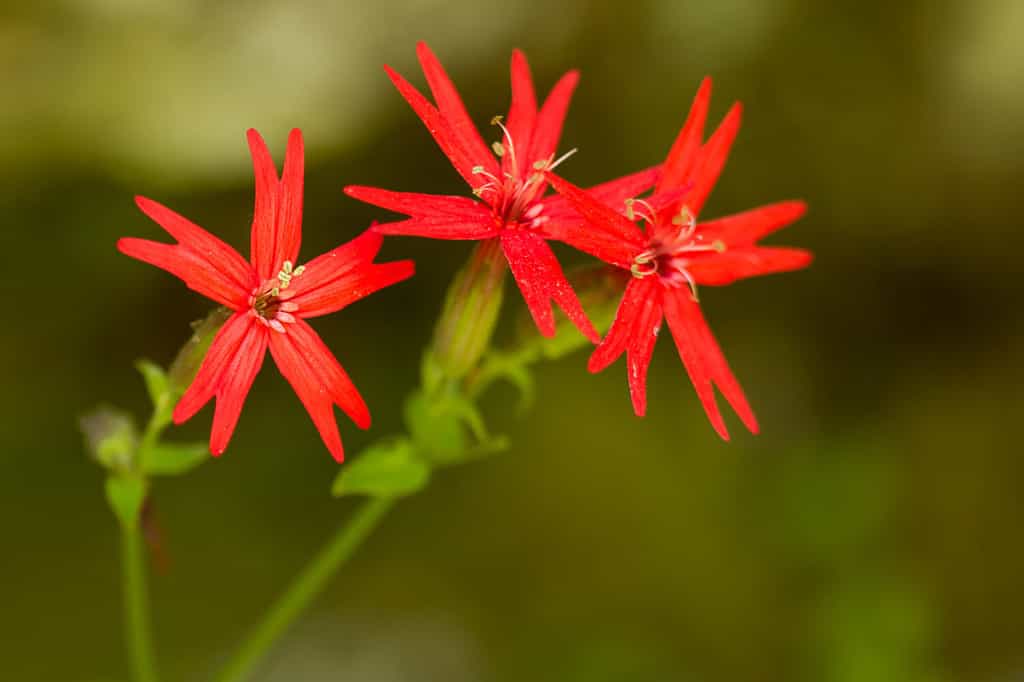
Fire pink flowers have unique petals.
©Agnieszka Bacal/Shutterstock.com
Also known as fire pink, this unique red wildflower boasts five petals with lobed ends and delicate sepals. This pollinator favorite is short-lived but full of nutritious nectar for butterflies and bees.
This resilient plant grows along the Eastern United States and up into Canada. You can find it in various environments, ranging from rocky slopes to lush woodlands. This hardy plant will grow in USDA zones 4-8.
16. Scarlet Cinquefoil
Botanical name: Potentilla thurberi
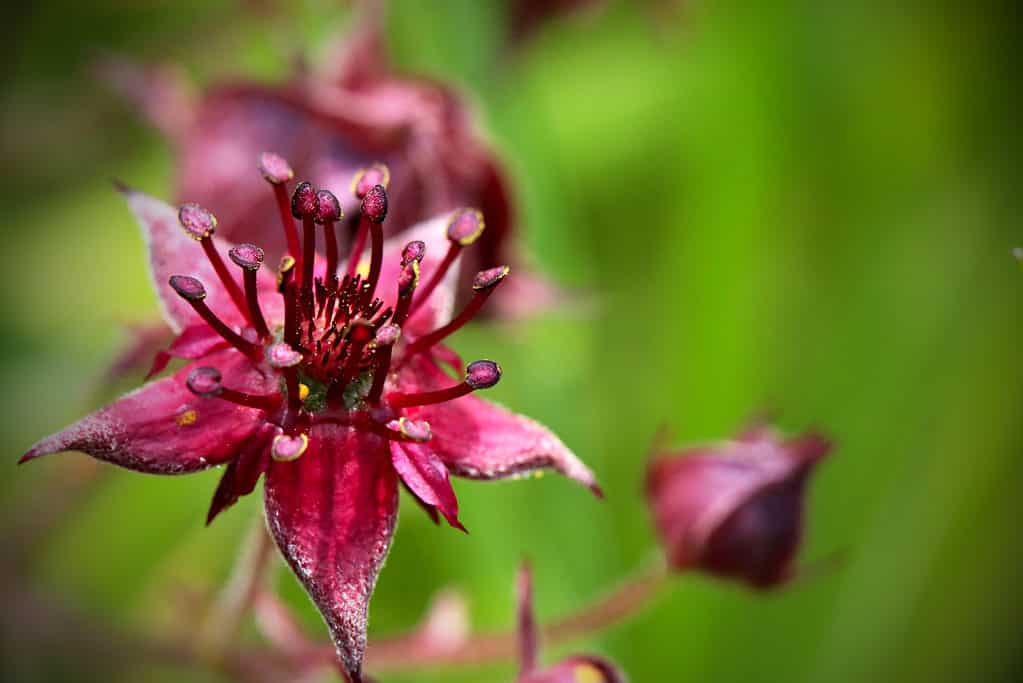
Closeup detail of blooming marsh cinquefoil.
©Jitka Sterbova/Shutterstock.com
The scarlet cinquefoil is a long-lasting bloom that thrives in the warm regions of the Southern US and parts of Mexico. It has soft petals and leaves, with pinkish-red blooms that deepen to a crimson-black in the center. Like many red wildflowers, this bloom has five broad, flat petals tapering at the center.
These wildflowers are potent pollinator attractors that appeal to butterflies and bees alike. There are several cultivars and varieties in varying shades of red. With proper care, this bloom will grow in USDA zones 5-9.
17. Scarlet Creeper
Botanical name: Ipomoea hederifolia
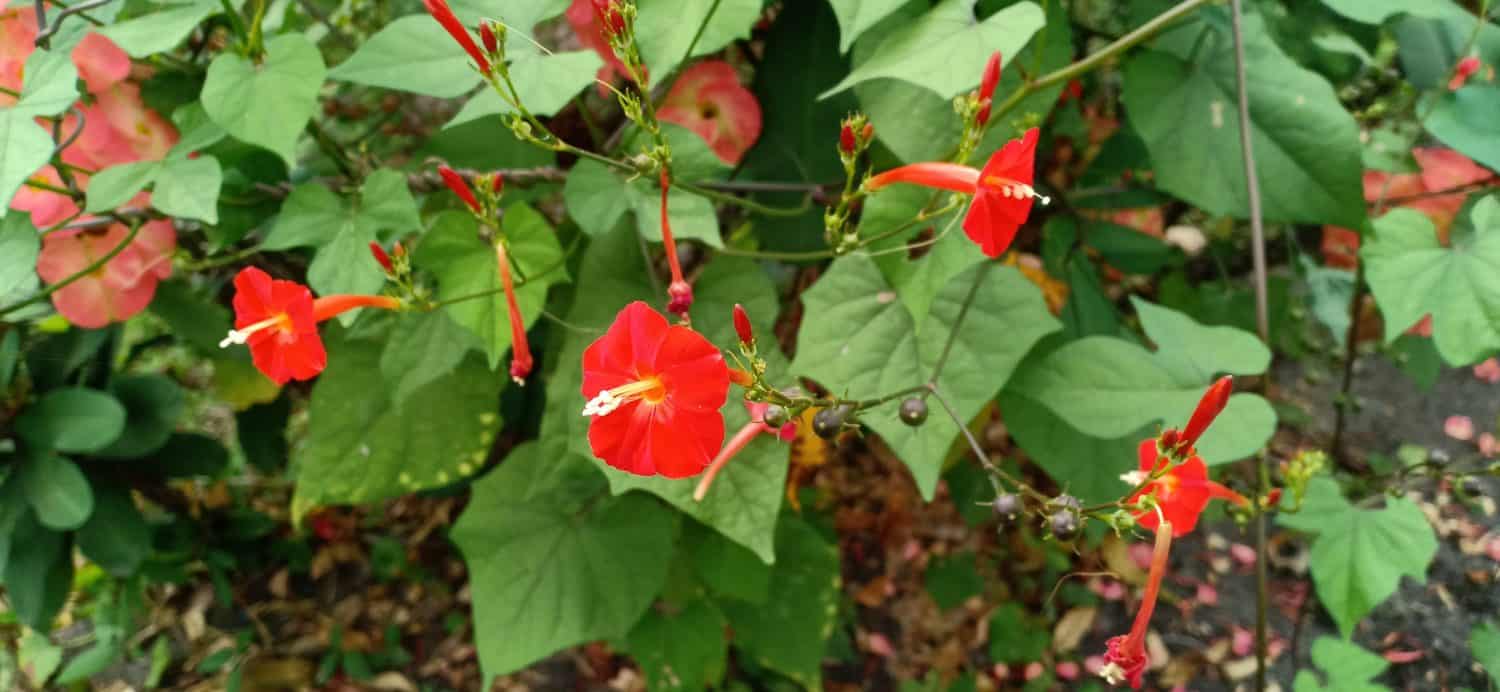
Scarlet morning glory is a climbing flower.
©Kezia Angeline/Shutterstock.com
Also known as the scarlet morning glory, this climbing flower has the traditional five broad petals with a twist: along the inside of the petals is a notable star shape that almost appears embossed for extra flair.
You can find this stunning plant throughout the Southern United States, Central America, and Mexico. It’s also been reported in parts of Asia, though this cultivar is often confused with similar flowers. It’s also possible that the scarlet creeper has been imported and naturalized.
This heat-loving plant will grow in USDA zones 8-11. It attracts pollinators and prefers a nice balance of humidity and well-draining soil.
18. Scarlet Lobelia
Botanical name: Lobelia spp.
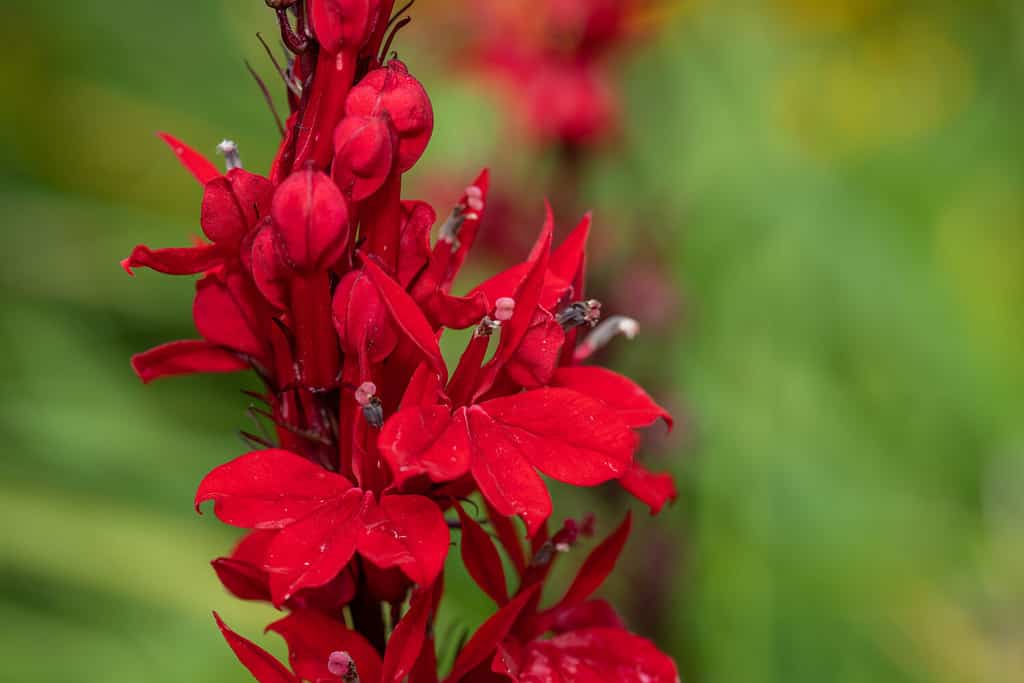
is an incredible red shade.
©Tom Meaker/Shutterstock.com
The scarlet lobelia, also known as the cardinal flower, refers to two primary species: Lobelia speciosa ‘Starship Scarlet’ and Lobelia cardinalis. Both of these incredible red wildflowers have bold petals and deep green foliage with purple notes.
These flowers are native to the Americas, ranging from parts of Canada all the way down to Mexico. It prefers USDA zones 9-11. While this wildflower performs well on its own, many gardeners report issues trying to grow it themselves. This high-maintenance wildflower prefers the perfect balance of moist but not too wet soil.
19. Scarlet Trumpet
Botanical name: Ipomopsis aggregata
Not to be confused with the trumpet vine, the scarlet trumpet is a member of the Polemoniaceae (phlox) family. This flower is also called the scarlet gilia or skyrocket. While its blossoms are trumpet-shaped, the outer petal tips fan backward as though blown back by a strong wind (or skyrocketed).
This unique wildflower grows best in rocky areas. You can find it in mountain ranges through the Western coast of the United States and into Texas.
This lovely red flower attracts local pollinators and grows best in USDA zones 5-8 throughout the summer.
20. Snow Plant
Botanical name: Sarcodes sanguinea

Snow plants aren’t white; they’re a deep red.
©3941105/Shutterstock.com
Don’t let the name fool you: the snow plant is a vibrant shade of red. It gets its name not for its color but for how it pierces through the snow as it grows in the mountains of California. Its true name, Sarcodes sanguinea, roughly translates to “bloody, fleshy thing,” which speaks more to its appearance.
The snow plant is incredibly rare and protected. The bright red tendrils of this plant grow upward in clusters, reaching 6-12 inches tall at maturation. It is illegal to pick or trample on this plant, which is a tourist attraction in California.
This one-of-a-kind red wildflower is a parasitic plant, feeding off nearby plants’ root systems. Due to its protected status and parasitic nature, don’t plan on growing this one at home.
21. Red Trillium
Botanical name: Trillium erectum
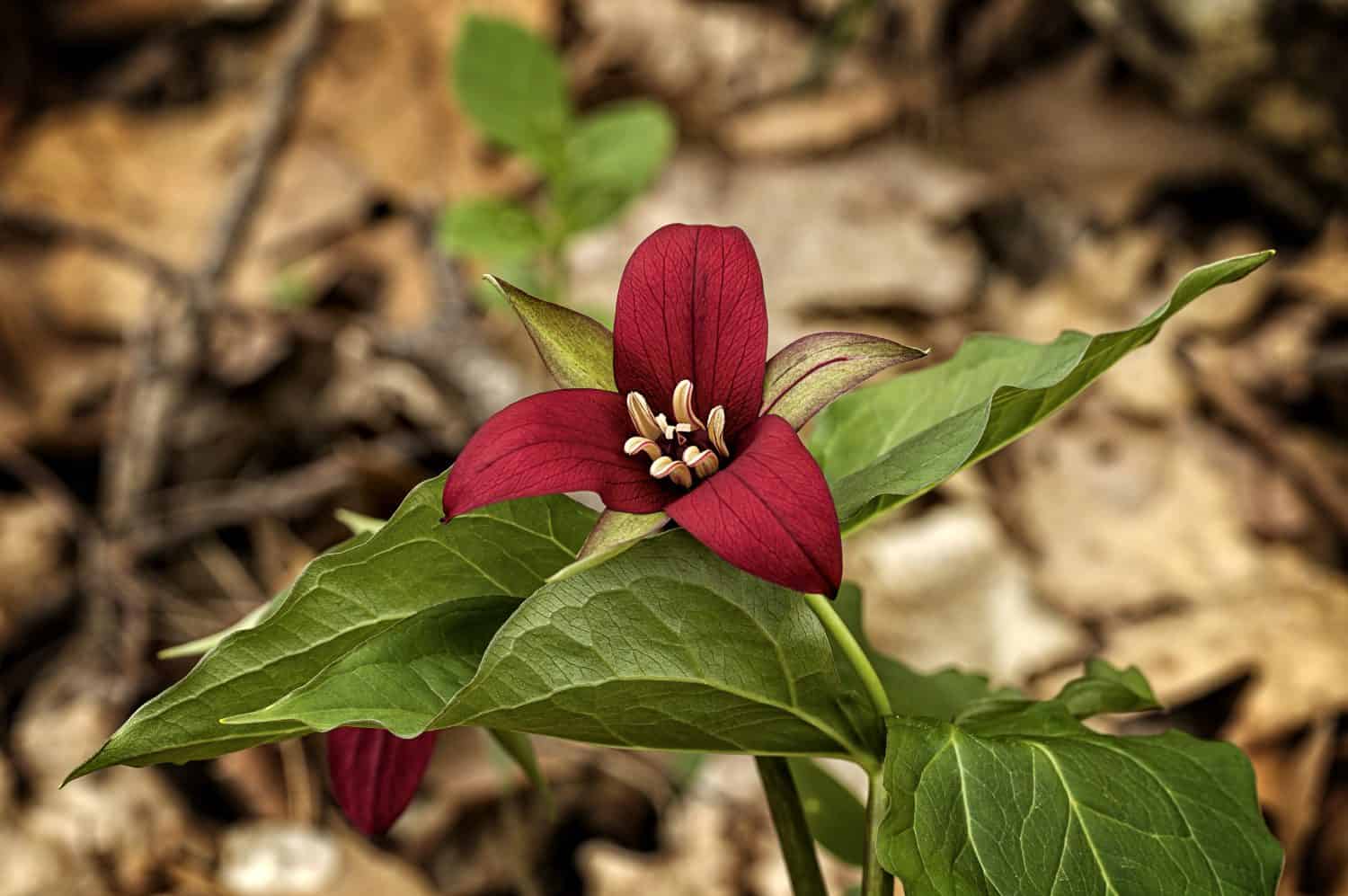
White trilliums are more common than red trilliums.
©Phill Doherty/Shutterstock.com
Trilliums are an incredibly common wildflower throughout Canada and the Northern United States. While these flowers are often white, there are also deep red and purple shades that add a lovely contrast along forest pathways.
These low-growing wildflowers have three distinct petals backed by three pointed leaves. The red trillium is also called the wake robin flower. This name pays homage to the red-breasted robin, which also signals the arrival of spring.
These cold-hardy flowers grow in USDA zones 4-7. You’ll often see them pop up in early spring or temperate winters.
22. Tropical Milkweed
Botanical name: Asclepias curassavica

Scarlet milkweed, also known as Mexican
butterfly
weed, tropical milkweed, cotton bush, and redhead, has a native range in southern North America, Central America, and South America.
©Jarun Tedjaem/Shutterstock.com
Tropical milkweed is a controversial plant. This bloom is the ultimate pollinator flower, attracting Monarchs on their journey south. However, it has invasive tendencies, and its potency often encourages Monarchs to abandon their migration, resulting in falling populations.
This beautiful flower has red, downward-sloping petals similar to a ballerina’s skirt and bright yellow upward-facing petals in a goblet formation. It grows in USDA zones 8-11. However, it’s essential to check local guidelines about restrictions and removal instructions rather than planting this wildflower.
23. Wild Poinsettia
Botanical name: Euphorbia heterophylla
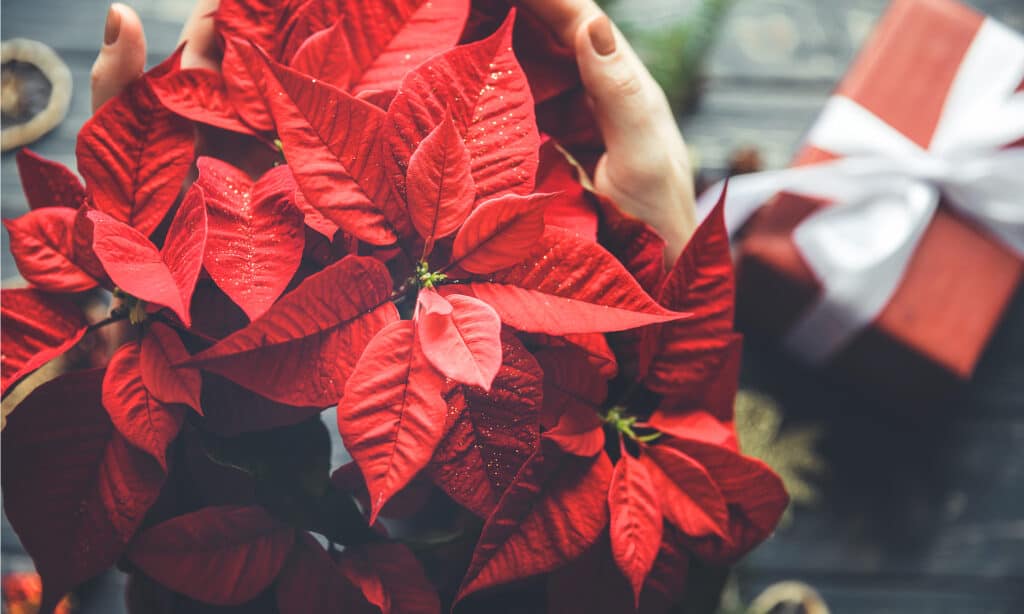
Poinsettias grow in the wild in Mexico.
©PinkCoffee Studio/Shutterstock.com
Poinsettias are well-known for their popularity at Christmas time. However, these flowers grow wild in their native Mexico.
These red wildflowers have elliptical crimson petals and similarly shaped green foliage. They grow in drier regions of the tropics and thrive in USDA zones 9-11. However, it’s entirely possible to overwinter these beautiful blooms indoors in colder climates.
Stunning Types of Red Wildflowers: A Summary
| Ranking | Type of Red Wildflower |
|---|---|
| 1 | American Trumpet Vine |
| 2 | Bee Balm |
| 3 | Blanket Flower |
| 4 | Buckhorn Cholla |
| 5 | Cherokee Bean |
| 6 | Common Poppy |
| 7 | Eastern Red Columbine |
| 8 | Indian Paintbrush |
| 9 | Indian Plume |
| 10 | Red Bush Monkeyflower |
| 11 | Prairie Smoke |
| 12 | Red Hibiscus |
| 13 | Red Salvia |
| 14 | Red Yarrow |
| 15 | Scarlet Catchfly |
| 16 | Scarlet Cinquefoil |
| 17 | Scarlet Creeper |
| 18 | Scarlet Lobelia |
| 19 | Scarlet Trumpet |
| 20 | Snow Plant |
| 21 | Red Trillium |
| 22 | Tropical Milkweed |
| 23 | Wild Poinsettia |
Thank you for reading! Have some feedback for us? Contact the AZ Animals editorial team.




